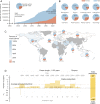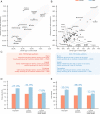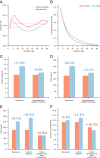Historical comparison of gender inequality in scientific careers across countries and disciplines
- PMID: 32071248
- PMCID: PMC7060730
- DOI: 10.1073/pnas.1914221117
Historical comparison of gender inequality in scientific careers across countries and disciplines
Abstract
There is extensive, yet fragmented, evidence of gender differences in academia suggesting that women are underrepresented in most scientific disciplines and publish fewer articles throughout a career, and their work acquires fewer citations. Here, we offer a comprehensive picture of longitudinal gender differences in performance through a bibliometric analysis of academic publishing careers by reconstructing the complete publication history of over 1.5 million gender-identified authors whose publishing career ended between 1955 and 2010, covering 83 countries and 13 disciplines. We find that, paradoxically, the increase of participation of women in science over the past 60 years was accompanied by an increase of gender differences in both productivity and impact. Most surprisingly, though, we uncover two gender invariants, finding that men and women publish at a comparable annual rate and have equivalent career-wise impact for the same size body of work. Finally, we demonstrate that differences in publishing career lengths and dropout rates explain a large portion of the reported career-wise differences in productivity and impact, although productivity differences still remain. This comprehensive picture of gender inequality in academia can help rephrase the conversation around the sustainability of women's careers in academia, with important consequences for institutions and policy makers.
Keywords: STEM; gender inequality; science of science; scientific careers.
Copyright © 2020 the Author(s). Published by PNAS.
Conflict of interest statement
Competing interest statement: A.-L.B. is founder of Nomix, Foodome, and Scipher Medicine, companies that explore the role of networks in health. All other authors declare no competing interest.
Figures




Comment in
- Do the social roles that women and men occupy in science allow equal access to publication?Proc Natl Acad Sci U S A. 2020 Mar 17;117(11):5553-5555. doi: 10.1073/pnas.2001684117. Epub 2020 Mar 3.Proc Natl Acad Sci U S A. 2020.PMID: 32127488Free PMC article.No abstract available.
Similar articles
- Gender trends in authorship of spine-related academic literature-a 39-year perspective.Spine J. 2017 Nov;17(11):1749-1754. doi: 10.1016/j.spinee.2017.06.041. Epub 2017 Jul 1.Spine J. 2017.PMID: 28673828
- Male principal investigators (almost) don't publish with women in ecology and zoology.PLoS One. 2019 Jun 19;14(6):e0218598. doi: 10.1371/journal.pone.0218598. eCollection 2019.PLoS One. 2019.PMID: 31216351Free PMC article.
- Perceptual Facilitators for and Barriers to Career Progression: A Qualitative Study With Female Early Stage Investigators in Health Sciences.Acad Med. 2021 Apr 1;96(4):576-584. doi: 10.1097/ACM.0000000000003902.Acad Med. 2021.PMID: 33369901Free PMC article.
- Gender inequality in academia: Problems and solutions for women faculty in STEM.J Neurosci Res. 2021 Jan;99(1):13-23. doi: 10.1002/jnr.24631. Epub 2020 Oct 25.J Neurosci Res. 2021.PMID: 33103281Review.
- Gender shapes the formation of review paper collaborations in microbiology.Proc Biol Sci. 2023 Jul 12;290(2002):20230965. doi: 10.1098/rspb.2023.0965. Epub 2023 Jul 5.Proc Biol Sci. 2023.PMID: 37403511Free PMC article.Review.
Cited by
- Reflections on motherhood and the impact of COVID 19 pandemic on women's scientific careers.J Neurochem. 2020 Dec;155(5):469-470. doi: 10.1111/jnc.15158. Epub 2020 Sep 27.J Neurochem. 2020.PMID: 32841368Free PMC article.No abstract available.
- Editorial: Women in science: Public health education and promotion 2021.Front Public Health. 2022 Sep 7;10:1011133. doi: 10.3389/fpubh.2022.1011133. eCollection 2022.Front Public Health. 2022.PMID: 36159276Free PMC article.No abstract available.
- Perception of work in the IT sector among men and women-A comparison between IT students and IT professionals.Front Psychol. 2022 Sep 9;13:944377. doi: 10.3389/fpsyg.2022.944377. eCollection 2022.Front Psychol. 2022.PMID: 36160560Free PMC article.
- Pre- and post-COVID-19 gender trends in authorship for paediatric radiology articles worldwide: a systematic review.Pediatr Radiol. 2024 May;54(5):831-841. doi: 10.1007/s00247-024-05855-2. Epub 2024 Feb 13.Pediatr Radiol. 2024.PMID: 38349519
- A gender perspective on the global migration of scholars.Proc Natl Acad Sci U S A. 2023 Mar 7;120(10):e2214664120. doi: 10.1073/pnas.2214664120. Epub 2023 Feb 27.Proc Natl Acad Sci U S A. 2023.PMID: 36848569Free PMC article.
References
- Ley T. J., Hamilton B. H., The gender gap in NIH grant applications. Science 322, 1472–1474 (2008). - PubMed
- Lariviere V., Ni C., Gingras Y., Cronin B., Sugimoto C. R., Global gender disparities in science. Nature 504, 211–213 (2013). - PubMed
- Shen H., Inequality quantified: Mind the gender gap. Nature News 495, 22–24 (2013). - PubMed
- Lincoln A. E., Pincus S., Koster J. B., Leboy P. S., The Matilda effect in science: Awards and prizes in the US, 1990s and 2000s. Soc. Stud. Sci. 42, 307–320 (2012). - PubMed
Publication types
MeSH terms
LinkOut - more resources
Full Text Sources
Miscellaneous

